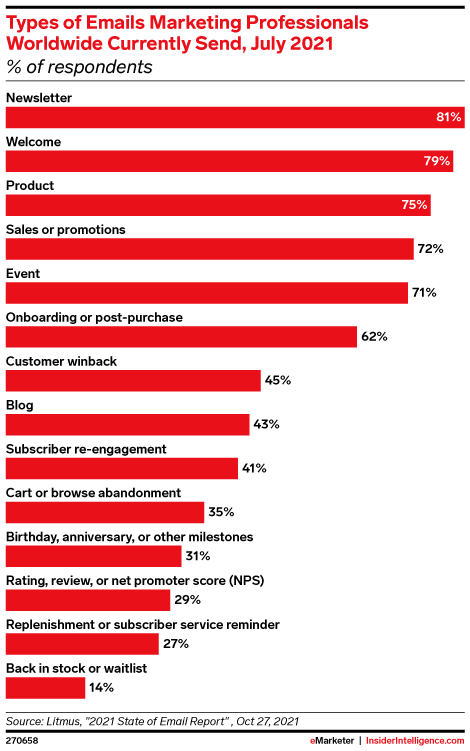2023 is setting out to be another challenging year for marketers around the world. To help you prepare and optimize your strategy in the new year, we’ve recapped the email marketing trends that will shape the world of email in 2023.
Email will play a key role during a period of economic uncertainty
Whenever the economy is unstable, companies tend to try and reduce their marketing budget in order to make ends meet. But is this really a wise decision?
Studies have proven that businesses that continue to invest in marketing during a recession are most likely to outperform their competitors. It is essential to evaluate channel performance during an economic crisis, as this helps you understand what channels are the most advantageous for your business when allocating your marketing budget.
Email’s unique ability to target subscribers with personalized and relevant messages makes it the best channel to drive revenue and improve customer loyalty – both top concerns for companies amid a recession.
Open rates will give way to more reliable email-tracking metrics
In 2022, we realized that open rates weren’t the sole indicator of success in email marketing.
In 2023, brands will need to set up attribution models and use UTMs with tracking capabilities to better measure how their emails help reach marketing goals. This way they’ll go beyond just measuring email open rates.
Email marketers should observe not only open rates, but also click-through rates, conversion rates, bounce rates and unsubscribe rates to measure the performance of their campaigns. At the same time, they should evaluate the quality and relevance of email content. All these metrics combined provide a comprehensive view of email marketing campaign success.
Zero-party data will power hyper-segmentation and hyper-personalization in email
According to a Salesforce study, 73% of global consumers are expecting companies to deliver custom experiences that can provide value for them along their journey. Moreover, customers are really wanting relevant experiences.
It’s been difficult for marketers to improve their email data – mainly from a technical standpoint, and more recently, because of stricter privacy regulations.Yes, creating personalized messages without seeming too intrusive can become even trickier. How do you customize your messages when new privacy policies make obtaining customer data harder and scarcer?
Going forward into 2023, the use of hyper-segmentation and hyper-personalization in email marketing will become commonplace, as long as customer privacy is being taken into consideration. Making sure to request the right data when signing up gives companies the chance to communicate with their users in an immediate and engaging way, without making them feel like someone’s been spying on their life.
Invest in your newsletter
While it’s easy to think of email solely as a sales tool, don’t forget that its real purpose is to create a connection between your brand and customers.
Production promotion and discounts are important, but newsletters remain the top choice for 81% of brands.

Newsletters that are done well can educate your audience and create an emotional connection with your brand. However, if the content is lackluster, newsletters can quickly become a nuisance. A lack of interesting topics is usually the primary cause for unsubscriptions.
Counteract this by giving your subscribers control over what they receive from you. Offering an email preferences center respects their time, inbox, and personal preference.
AI tools and features will help power email marketing performance
If you’ve recently been on LinkedIn, then you’ve likely encountered a plethora of conversations about whether AI is taking over all the jobs. Talk of ChatGPT and other AI-based resources abounds, and data from Omdia suggests that the AI industry will grow 38% in 2023.
While AI may seem intimidating to some traditional marketers, it can also be a great asset that can make senders more efficient and successful. Don’t worry, AI won’t replace email marketers, but those who dare to explore its potential will have an edge on the competition.

AI market revenue is predicted to increase by 38% in 2023
AI can improve email decisions, like coming up with effective subject lines or deciding the optimal time for delivering emails with tools like Mailgun’s Send-Time Optimization. AI can also provide details about email addresses’ validity through active or inactive status.
In the next few years, Artificial Intelligence will be more widespread in email marketing, so it’s important to learn how to use it for successful campaigns. At Digital Motion, we’re dedicated to providing helpful resources and knowledge on the topic.
Check out our blog and newsletter to stay informed and grow your email marketing skills.
